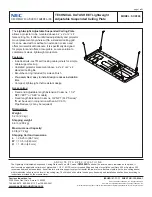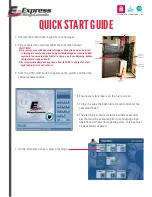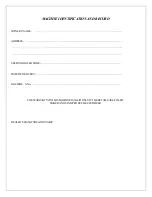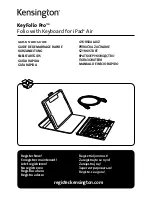
Page 7 of 7
109-6609 Rev. C
position. Pull outward on the PTO switch to the
“ROTATE” position.
3. To disengage the deck drive and blower, set the
throttle to “midway” position. Push in on the PTO
switch to the “STOP” position to stop the cutting
blades and blower. The cutting blades will require a
slightly longer amount of time to come to a complete
stop when the blower is installed on the deck.
Fill Sensor
The fill sensor is located at the front of the hopper, and is
wired into the PTO circuit. When grass fills the hopper
enough to block one or both sensors, an alarm will sound.
The fill sensor testing must be made with the PTO
engaged, but the engine does not have to be running.
1. Stop engine, wait for all moving parts to stop, and
remove key. Engage parking brake. Unlatch the door
and pull the door handle engagement pin to raise the
door to the top of the hopper (see Figure 15.)
FIGURE 15
2. Reach into the hopper and place a piece of masking or
duct tape over the LH sensor. It may be helpful to
remove the screen as shown in Figure 15.
3. Close
the
door.
4. Sit in the seat and turn the key to the RUN position, but
DO NOT START
the unit.
5. Pull up on the PTO switch to engage power to the
clutch; you should hear a click from the clutch.
6. There is a split second delay before the fill sensor
alarm will sound.
7. Repeat steps 1-3 to remove the tape from the sensor.
Adjustments
The FrontRunner Ultra Vac was adjusted at the factory
to operate properly. However, there are three basic
adjustments that can be made, should your unit require
them:
1.
Fill sensors:
Located inside the hopper, they
sound an alarm when the hopper is full. They
can be adjusted for varying grass conditions that
fill the hopper differently (see Figure 16).
FIGURE 16
Moving the LH sensor up works better in wetter
conditions.
Moving the LH sensor down works better in
dryer conditions.
2.
Latches:
The latches (Figure 17) can be
adjusted. With the door closed, the latch plate
should be set so that the latch cams completely
engage and contact the latch plates bolted to
the door.
FIGURE 17
3.
Latch handle link:
The latch handle needs to
be able to snap over-center to keep the latch
cams tight against the door latch plates and the
door pulled shut. The length of the latch linkage
is controlled by the two whizlock nuts on either
side of the latch link (Figure 17). The whizlock
nuts should be adjusted so that reasonable
force on the handle is required to over-center
and latch the door. Do not adjust so that the
over-center spring collapses completely when
the door is fully latched.

























